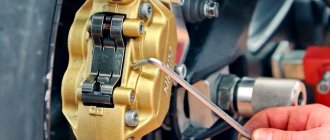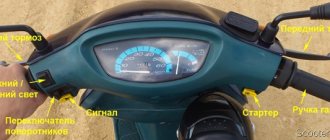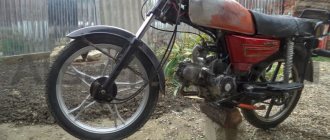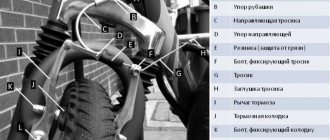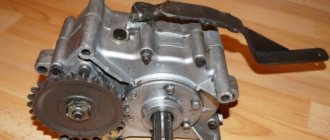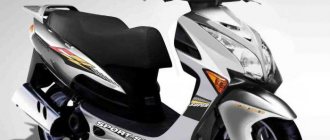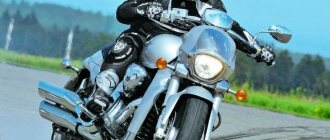Bleeding the motorcycle brake system
Bleeding the brake system begins with bleeding the master cylinder.
On some motorcycles, the master cylinder (brake machine) of the front brake system does not bleed. In our case, the master cylinder has an air bleed fitting, so it needs to be bled.
On all motorcycles, the rear brake master cylinders are not pumped; they automatically bleed air into the reservoir by shortening the brake lever.
Pour brake fluid into the reservoir.
If the master cylinder has an air bleed fitting, bleeding begins from there, then the slave cylinder is pumped. Otherwise, only the worker is pumped.
We put the hose on the fitting. Lower the free end of the hose into the container.
We make several contractions of the brake lever (squeeze sharply, release slowly), then squeeze the lever and keep it tense (press). The fitting is closed.
Open the fitting. The brake lever “falls” and fluid comes out of the hose. Check for air bubbles in the escaping liquid. Close the fitting. If there are bubbles, repeat steps 4 and 5 until the bubbles disappear. Don’t forget to monitor the liquid level in the tank; when it drops, add more.
Add liquid to the reservoir to the maximum level. Not to capacity, but to the maximum level, which is indicated on the tank (see photo). We close the tank. The system is pumped.
Thus, for the rear brake system, only the slave cylinder needs to be bled. For the front - a master cylinder (if necessary) and two workers.
Differences and specifics of bleeding brakes with ABS
The anti-lock braking system allows you to control the vehicle's handling when braking. After pressing the pedal, the central control panel receives a response signal from sensors installed on the front and rear wheels. Thanks to the control system, the wheels slow down at the same speed as the car itself. In other words, thanks to ABS, the car cannot skid.
Regardless of the manufacturer, most devices have common characteristics:
- Electronic speed sensors on the hubs;
- Pressure controllers for main brake fluid lines;
- Electronic unit for signal processing.
Unlike most cars with simple braking systems, bleeding anti-lock brakes is difficult. For the procedure to be successful, it is necessary to familiarize yourself in detail with the theory of ABS operation. However, if the hydraulic accumulator, valves and pump are located nearby due to the design solution, the pumping technology will be very similar to the standard one.
Before starting work, in addition to standard tools, you must acquire a scanner to read information from the electronic unit. However, if the car has additional sensors, it is better to take the vehicle to a specialized salon. Any improper intervention calls into question the safety of road users.
Usually, for successful bleeding with the ABS system, it is enough to monitor the pressure in the hydraulic system. The standard value is 180 atm, but to work with the brakes it must be reduced - turn off the ignition and apply the brake 20 times. Only after this, some of the liquid will splash out and the pressure will drop significantly. After reducing the pressure, you can begin to turn off the ignition and disconnect the connectors and controllers on the GTZ tank for further manipulations.
The brake bleeding diagram, or, in other words, the brake bleeding sequence, should look like this:
- front left wheel mechanism;
- front right wheel mechanism;
- rear right wheel mechanism;
- rear left wheel mechanism.
- front right wheel mechanism;
- front left wheel mechanism;
- rear left wheel mechanism;
- rear right wheel mechanism.
Starting the pumping procedure itself, provide comfortable access to the relevant mechanisms with which you will work - remove the desired wheel, or drive the car into the inspection hole. Procedure for bleeding the brakes.
- Remove the cap from the expansion tank.
- Unscrew the brake bleeder fitting and clean it of any buildup.
- Place a clean hose onto the fitting of the corresponding brake mechanism, lowering the free end into a reservoir filled with brake fluid. Due to the fullness of the container, air does not enter the cylinder through the fitting.
- Start the engine and leave it running.
- Press the brake pedal several times (your assistant can do this) until the brake fluid flows through the hose into the reservoir. Perform these actions as long as the brake pedal allows, until it hits the floor.
- Bleed the brakes until all the air is out of the mechanism, while constantly refilling the reservoir with new brake fluid. The tank should not be completely empty, otherwise it will fill with air again. This system is used for cars with a manual transmission.
- Tighten the abs bleeder fitting. Tighten it while the pedal is reversed to prevent air from entering.
- Remove air and fluid from the clutch hydraulic drive as well.
- Add fluid to the expansion tank to the maximum mark.
- Check the action of the brake pedal; it should be depressed 1/3 of the entire pedal stroke.
In any case, before starting pumping, read all the nuances in the technical documentation for the car.
Problems with the fuel mixture
If a new scooter does not pull well, the rider needs to check the fuel composition. A mixture that is too rich or too lean will worsen the dynamics, causing acceleration to become sluggish. Therefore, you need to make sure that the ratio of oxygen and gasoline is selected correctly:
- If the mixture is lean, the spark plug electrode becomes white and begins to overheat and melt.
- If the composition is rich, soot will appear on the candle.
Problems with preparing a combustible mixture can arise due to a clogged air filter or a breakdown of the starting enrichment.
Drum Brake Adjustment
Adjusting the drum brake involves setting the free play of the rear brake lever.
The free play of the drum brake lever is determined by the distance from the beginning of the handle movement to the grip. Normal free play of the drum brake lever should be within 10 ... 20 mm.
Procedure for adjusting drum brakes on a scooter:
- Place the scooter on the center stand
- Clean the threaded part of the cable from dirt
- Adjust the free play of the drum brake lever by rotating the adjusting nut, which is located at the end of the brake cable near the wheel hub. To decrease the free play, you need to rotate the adjusting nut clockwise, and to increase the free play, you need to rotate it counterclockwise. It may be necessary to hold the cable to prevent it from turning along with the adjustment nut
- After setting, you need to make sure that the wheel rotates freely and without jamming
- Check the serviceability of the brake drive (cable) and drum brake lever
If the threaded part is not enough to adjust the free play of the control lever, then you can adjust the brake by moving the brake lever by 1-2 slots.
If after tightening the drum brakes their performance has not increased, check the condition of the brake pads and change them if necessary.
Fines and basic rules in Phuket
It is important to remember that in Thailand you drive on the left. We strongly advise you to review Thai traffic rules and tips for driving on Thai roads.
If you plan to frequently ride a moped, scooter, or bike in Phuket, we recommend purchasing a good helmet. When renting a bike, they sometimes give you helmets for free, however, they are most often very flimsy.
Video about how to operate a bike and how to ride correctly in Thailand
IMPORTANT : Do not get on the bike if you have drunk even 1 glass of alcohol. For drivers over 24 years of age, the norm is 0.5 ppm. For drivers under 0 ppm.
Punishment can be up to 1 year in prison or a fine from 5,000 to 20,000 baht (8,500-34,000 rubles), deprivation of the right to drive for 6 months.
Bleeding the car's brake system and removing air from it.
To bleed the brakes you need to take keys of different sizes, brake fluid and a clean plastic or glass container and hose. In addition, you will have to call your friend or someone from your household to help in the process.
After this, you need to conduct a visual inspection of all components and mechanisms of the system, as well as hoses and tubes. If any element is found to be faulty, it must be replaced or repaired. If there is no visible damage, you can proceed directly to pumping.
- Each brake disc has a fitting. We put a hose on it, and lower the other end of the hose into a container with brake fluid. Add liquid to the reservoir to the highest level.
- Next, the assistant makes 4 presses on the pedal, and then leaves it in the lowest position. Next, you need to unscrew the bleeder fitting by about 1-1.5 turns. Liquid should come out, which is squeezed out by the pressure created in the system. Along with it, air will come out in the form of bubbles. As soon as air stops escaping, you must immediately return the fitting to the closed position.
- Bleed the remaining wheels in the same way.
This bleeding method is applicable to trucks and cars with conventional hydraulic or pneumatic brakes. For a brake system with ABS, bleeding is carried out a little differently, because the operating principle is different.
Moscow Scooter Club
Time zone: UTC + 4 hours [Summer Time]
Forum Rules
BE SURE to indicate the model, unit and symptoms of the malfunction in the title of the topic.
Heading form: [SCOOTER MODEL] - unit malfunction Example: [Dio] electric starter does not work.
If the topic concerns general repair issues, the model may not be specified.
The main rule is that the title of the topic should be brief, but as fully as possible reflect its content. Topics whose title does not indicate at least the approximate essence of the question, such as “AAA. Save!”, “I have a problem, tell me,” will be DELETED .
Replacing brake fluid and bleeding brakes
The brake fluid on a scooter, like any other vehicle, should be changed at least every two years. Fortunately, on a scooter this is such a simple procedure that it can be done at least every season (although it doesn’t make sense to do it this often). Time costs – 5-10 minutes for preparation and replacement.
The main thing is to do everything carefully, then you will be able to avoid unnecessary actions.
To get started, you should stock up on the following items:
- brake fluid DOT 4
- empty container
- straw
- socket wrench 8
- crosshead screwdriver
First you need to prepare a drain for the old fluid. To do this, remove the rubber plug from the drain fitting.
We put a spanner on the fitting, then we put a tube on it, the end of which we lower into the container.
We will change the brake fluid by gravity, without pumping. An important aspect of this replacement method: do not allow air to get into the brake line, otherwise you will have to bleed it - which, of course, is not terrible, but this is an unnecessary step.
Unscrew the bolts of the brake reservoir cap, remove the plug and rubber membrane.
The brake fluid in the reservoir will be something like this:
Uncork the bottle of brake fluid.
Now use a wrench to unscrew the fitting about a quarter of a turn (or even less). There is no need to unscrew it too much, otherwise air bubbles will appear. The brake fluid should slowly pour into the container.
As the brake reservoir is emptied, add new brake fluid.
It is very important that the tank is always filled with liquid! After some time, the old liquid will drain and new liquid will go down the drain, this is always visible by color
After some time, the old liquid will drain and new liquid will go down the drain, this is always visible by the color.
The volume of three or four brake reservoirs is enough to flush everything.
Close the fitting, add fluid to the tank to the level, and you're done!
Bleeding method
However, if at some point you leaked fluid and air got into the brake line, then it will not drain by gravity. Then we will use the pumping method.
- Filling the brake reservoir.
- Using an open-end wrench, open the drain fitting half a turn.
- We squeeze the brake handle all the way and do not release it.
- While pressing the handle, close the fitting.
- Let's release the handle.
- Repeat steps 2-5 until all air bubbles come out of the tube (without forgetting to replenish the liquid in the tank).
https://youtube.com/watch?v=2UQb9WjJKtI
Useful tips
When removing the diaphragm, you should use a napkin to protect yourself from spilling liquid from the tank, as it is very aggressive and can ruin the painted surface of the scooter.
The liquid level in the tank is constantly monitored, adding it if necessary. If the system catches air, a new pumping is inevitable. If overflow occurs, painted parts will be damaged.
After filling the tank with liquid, you need to drive for several kilometers at low speed in order to repeat the pumping if necessary. It is convenient to work with an assistant who, on command, will press the brake handle while the scooterist uses an open-end wrench to release the bleeder fitting half a turn. When a portion of the liquid flows out (the lever must not be released!), you can tighten the fitting. Press the handle until it falls through. We tighten it completely without much zeal, so as not to break the aluminum thread.
When bleeding, it is useful to tilt the scooter so that the intake hole in the reservoir is higher than the bolt of the brake hose fitting (without “exposing” them to air); if you press the brake lever a couple of times, the bubbles will have no chance to hide.
Having spent half an hour on the whole operation, we get tenacious, informative brakes, the reliability of which you can not doubt.
Once again about the reasons
Air in the brake system may appear for the following reasons:
- the amount of brake fluid in the reservoir of the main brake cylinder has significantly decreased, which has led to the “entrapment” of air; as a rule, this reason is closely related to subsequent reasons;
- wear of the sealing cuffs, both in the main brake and working cylinders;
- loss of tightness in the connections of brake pipes and hoses; as a rule, rubber brake pipes must be replaced every 4 years;
- loss of tightness in the rubber brake pipes themselves due to their natural wear;
- loss of tightness in metal brake pipes due to their corrosion.
This is usually manifested by the presence of smudges in the locations of the structural elements of the vehicle’s braking system. In this case, the trip should be postponed and all measures should be taken to eliminate the brake fluid leak and air the brake system.
Read on topic: How to bleed brakes without an assistant.
Another reason why air appears in the brake system and, accordingly, its low efficiency is the failure to replace the brake fluid in a timely manner.
The fact is that any brake fluid is hygroscopic and accumulates a large amount of moisture over time. For example, in NEVA brake fluid, this can be seen by its dark color.
The brake fluid should be changed approximately once every two years. If this is not done, the following may happen.
During prolonged braking, especially on a mountain road, when drivers forget about engine braking, all brake elements become very hot, and accordingly, the brake fluid will also heat up.
The new brake fluid can successfully withstand all these loads, but the old fluid, with the presence of moisture, can let you down.
The boiling point of such brake fluid is much lower than the standard (about 200 degrees Celsius), and accordingly the likelihood that it will boil becomes very high. During boiling, air bubbles form in the system, and air appears again in the brake system.
Read on topic: How to change brake fluid.
Therefore, try not to forget about this method of braking, such as engine braking.
As we see, air in the brake system is the first enemy of the brakes, so it is necessary to constantly monitor the condition of the brakes, both in the garage and while the car is moving.
The presence of brakes is the first criterion for your safety and the safety of your family and friends, do not forget about it.
Interesting note - Disc and drum brakes from "Main Road".
Therefore, there should always be no air in the car’s brake system.
